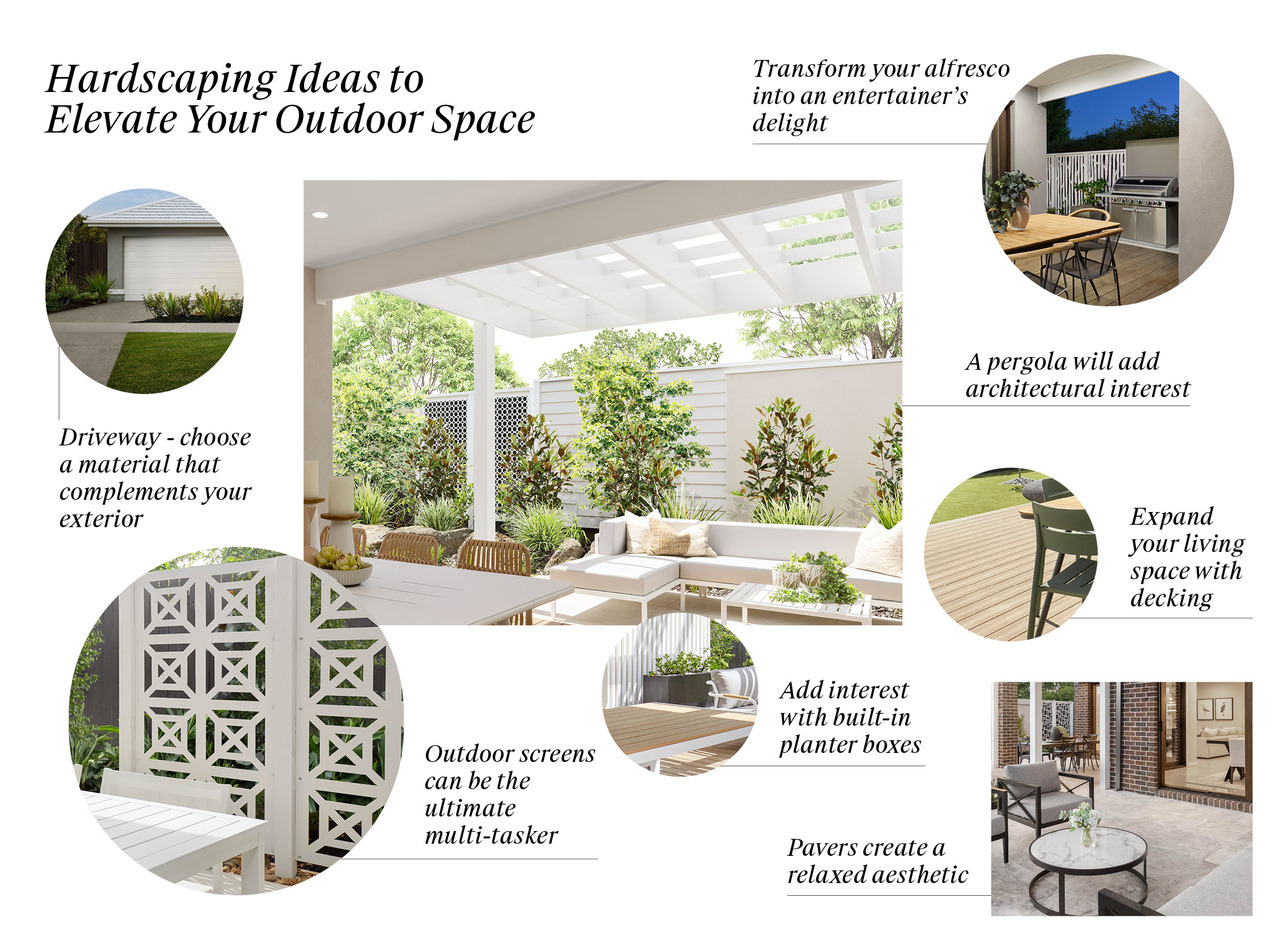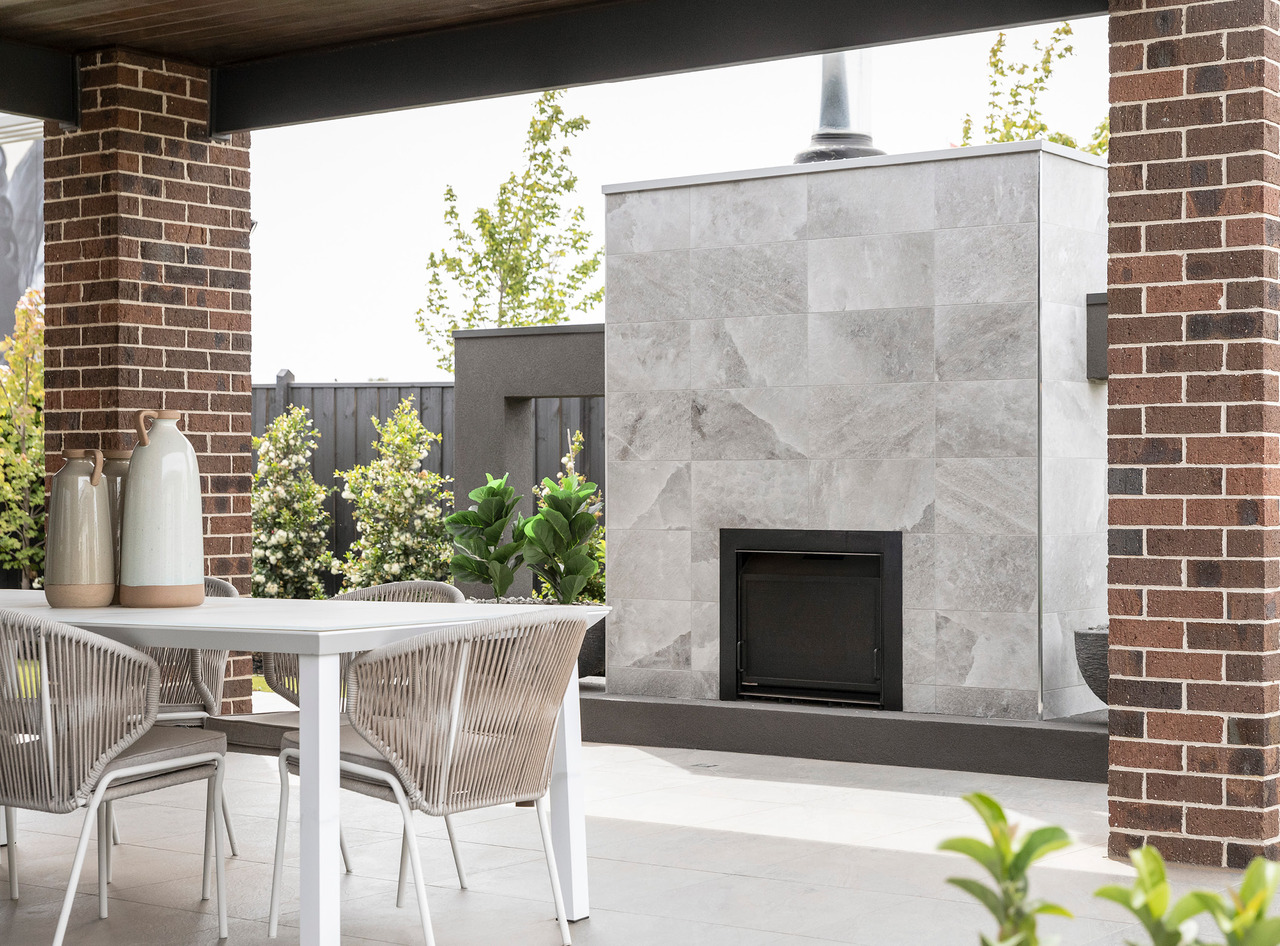8 Hardscaping Ideas to Elevate Your Outdoor Space

From decking and pavers to outdoor fireplaces, our landscape design expert reveals the eight hardscaping elements that will take your garden to the next level.
While greenery adds colour and beauty to your garden, it’s hardscaping that brings the functionality. A well-designed garden needs a mix of both.
Hardscaping refers to the hard or non-living elements of your landscape, like pavers, decks, pergolas, outdoor fireplaces and kitchens. They can be formal or informal in style, depending on the look of your facade and the surrounding landscape.
So, what hardscaping do you need, and how can it make your outdoor spaces more inviting and user-friendly? We got the lowdown from Mark Browning, landscape designer and principal at Mark Browning Landscape Design, who has designed over 500 stunning gardens in Carlisle display homes across Melbourne and Geelong, to find out.

Hardscaping features like pavers, decking, screens and planter boxes have an important role to play in your outdoor scheme, adding functionality and architectural interest. When planning hardscaping, consider how you want to use your exterior and the colour and style of your facade.
Paving
Be it natural stone, concrete, tile or brick, pavers are the first part of your landscape that visitors will experience.
You can use pavers to create front paths, patios and driveways, frame flower beds or design individual zones within your garden, in shapes and colours that complement your home’s facade. Square or rectangular pavers will give you a more formal or contemporary look (and they’re generally the most cost-effective), while curved and irregularly shaped pavers will create a more relaxed and organic aesthetic.
Every Carlisle display exterior scheme features beautiful paving, carefully selected to complement the greenery. “When paving the front yard of Carlisle display homes, our preference is always natural stone for porches and alfresco areas. We avoid extremes in tones, such as black and white, and will generally use softer grey tones,” says Browning.
Built-in planter boxes
Integrated planter boxes serve a practical function, holding or retaining soil, while adding architectural interest to your landscape. Fill them with flowers and plants, and you’ll find the contrast between hard and soft adds instant wow factor. “We often incorporate built-in planter boxes in Carlisle displays, mainly in front gardens,” says Browning. “They provide interest and focus, as well as an opportunity to use more diverse landscape materials.”
They also let you get creative, with the potential to add in seating nooks, tiered sections and more. “In rear gardens, we frequently incorporate built-in seating and planting in feature pots,” he says.
You can create built-in planters from a variety of materials, including timber (paint them in a colour that matches your exterior for a cohesive look), concrete and stone.
Looking for some low-cost, high-impact planting ideas? Check out this article.
Decking
Nothing expands your living space faster than a deck – it gives you a whole extra room, instantly.
Most decks are made from natural timber, bamboo or timber-look composite boards, which combine synthetics and wood fibre to create a low-maintenance material that will maintain its good for years. “With our Carlisle display homes, we generally use composite decking boards for their practicality as these homes get a lot of foot traffic,” says Browning.
“In situations where natural timber decking is appropriate, I like to use timber species that don’t require staining or oiling, and will grey off naturally, which many hardwood species will do,” he says. “It is important to understand that as soon as real timber is oiled or stained, its ability to ‘breathe’ is compromised, and this is what causes timber to ‘cup’ and become unstable.”

You can take your alfresco entertainer’s terrace to the next level by adding hardscaping features like an outdoor kitchen, a pergola, built-in planter boxes and an outdoor fireplace that provides warmth and cosiness to the space all year round.
Outdoor fireplace
There’s nothing quite like cosying up around an outdoor fireplace on those cooler nights, which is no doubt why this feature is top of the wish list for many homeowners.
Not only does an outdoor fireplace create an enticing focal point in your outdoor area, but it means you can use the space practically year-round. “We frequently add fireplaces to the alfresco areas of Carlisle display homes,” says Browning. “They improve usability of these areas and make them feel very inviting.”
As with any heating feature, choosing the right fuel type is crucial. “With the Victorian Government’s initiative to phase out gas appliances in all new homes, careful consideration needs to be given to the choice of fireplace – and this applies to barbeques too,” says Browning. “Bottled gas and ethanal-fuelled appliances are still permitted. But wood fires are problematic as smoke pollution is highly frowned upon in high-density urban environs.”
Alfresco kitchen
Transform your alfresco into an entertainer’s delight by adding a built-in outdoor kitchen. “Outdoor cooking is a great addition to an outdoor space, and built-in barbecues and joinery are popular and add value to your home,” says Browning.
Browning’s top tip? Pay attention to size and positioning. “Consideration needs to be paid to placement and the area taken up – there’s little point in having a big, flash barbeque if it takes up too much space and pushes your outdoor dining space beyond the alfresco.
“If outdoor space is limited, consider a portable barbeque that can be wheeled away when not in use,” he says.
Screens
An outdoor screen can be the ultimate multi-tasker, making it a great addition to your outdoor area. “Steel, powder-coated aluminium or timber screens can be used as both a feature in your landscape, and to conceal less exciting elements, such as clotheslines, bins, air conditioners and hot water services,” says Browning.

A pergola or a fixed or retractable overhead screen makes a great addition to your outdoor living space, providing shade and shelter on those hot summer days and a sense of privacy. Add climbing vines or fairy lights for added beauty and ambience.
Pergola
A pergola is a clever way to add architectural interest to your outdoor space, while providing shade and privacy. “Add a pergola as an extension to your alfresco, as we frequently do in Carlisle display homes, and you can effectively double your outdoor living space. This improves the functionality of your outdoor area, especially in new estates where tree cover is yet to be established,” says Browning.
For added ambience, adorn your pergola with a climbing vine like Chinese Star Jasmine or Ornamental Grape or some string lights, he says. “Pergolas can also be covered with shade battens or a solid or retractable screen to provide further shade, but be aware these can get costly,” he says.
Driveway
Driveways often get taken for granted, but given they make up a large part of your home’s exterior look and kerb appeal, they deserve decorative attention. For a seamless aesthetic, choose a material that complements the colours and style of your exterior. Concrete, pavers, gravel and grass-block pavers are all popular choices.
“Gone are the days of plain concrete,” says Browning. “For driveways, I recommend washed or exposed aggregate concrete – there are literally thousands of different mixes available to suit any colour palette. It’s also important to choose colours that match those on your exterior – a philosophy I apply to paths and other paved areas too.”
Want some hardscaping inspiration? Pop along to one (or more) of our 70+ display homes, where Mark Browning and his team have created stunning exterior looks for maximum wow factor.
